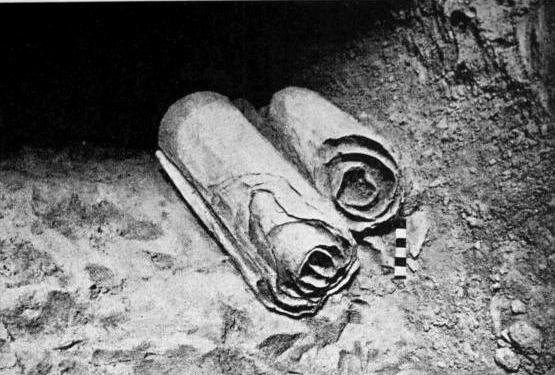H4見出しa
H4見出しb
(前記事から続く)
偽物は見つけられるのか?
[toggle]For example, only about a quarter of the fragments found in the caves around the Dead Sea in the 1940s and ’50s contained biblical texts. The majority were copies of texts from the expanding literature of Judaism in the Second Temple period and the community that lived at Qumran. But the fragments that have appeared for sale in recent years have all featured portions of the Bible.They were not the passages a Christian would most likely choose for a life verse, but they were Scripture nonetheless: 1 Kings 13:22, Isaiah 28:23–29, Joel 3:9–10, and Amos 7:17.
Lanier checked the documentation of the provenance of the fragments at Lanier Library again to reassure himself.
Documentation can be fraudulent, but it creates a legal responsibility for authenticity. Azusa Pacific University has concluded the five fragments it bought for $1.3 million are probably not authentic. The school is suing the book dealer who brokered the sale.
Southwestern Baptist Theological Seminary considered investigating its eight fragments, which it bought with the help of two major donors in 2012, but decided against spending more money on independent authentication. The school recently closed its archaeology program as part of an “institution reset” with a change in administration.
“The fragments are in a secure location and have not been available to the general public in some years,” the seminary said in an official statement. “We would welcome an independent investigation of the seminary’s fragments, although . . . it is not prudent for the seminary to spend further precious funds on them.”
Loll said Art Fraud Insights is doing a number examinations of scroll fragments for worried collectors.
“The only way to really be certain that they are genuine is to, of course, put them through the kind of rigorous testing that the Museum of the Bible did. But that’s expensive,” said Sidnie White Crawford, antiquities expert and professor emerita at the University of Nebraska–Lincoln. [/toggle]
1940年代から50年代に死海地域の洞窟で見つかった断片のうち、聖書テキストが含まれていたのは約4分の1だけだ。それ以外は第二神殿時代に栄えたユダヤ教文学や、クムラン区域に住んでいたコミュニティで読まれていた文学の写本だった。しかし近年売買された写本には、なぜかすべて聖書テキストが含まれている。
そこに記されていたのはクリスチャンが「座右の聖句」にするような箇所ではないが、聖句であることに変わりはない。
これまでに偽物が見つかった写本には以下の聖句が含まれている。
列王上13章22節
イザヤ28章23–29節
ヨエル3章9–10節
アモス書7章17節
ラニア氏は、自らを安心させるためにラニア神学図書館に所蔵されている断片の出所をもう一度見直したという。購入の際についてくる保証書が詐欺の一環である可能性はあるが、少なくともそれによって法的責任は生まれる。同様に死海文書の写本を所蔵していたアズサ太平洋大学は、130万ドル(約1億3570万円)で購入した断片が本物である可能性は低いという結論に至り、売却を仲介した業者を提訴している。
サウスウエスタンバプテスト神学校は、支援者2名からの大口資金援助を受けて2012年に8つの断片を購入している。調査も検討したが、高額の費用がかかる独立機関による調査の実施を断念した。同校は最近、政府の変更に伴う「組織変革」の一環として、考古学部門を閉鎖している。
同校の公式声明によると「断片は安全な場所に保管されており、ここ数年は一般に公開されていない。これらの断片について独立機関による調査を行うことは歓迎だが(中略)本校がそのために貴重な資金を費やすことは賢明ではないと判断している」という。
調査団体「アート・フロッド・インサイツ」の元には不安を抱えるコレクターからの写本の調査依頼が舞い込んでいると同団体のロル代表は言う。
ネブラスカ大学リンカーン校のシドニー・ホワイト・クローフォード名誉教授(古美術)は「当然ながら、写本が本物であることを確実にする唯一の方法は、聖書博物館が行ったような厳格な調査を行うことです。かなり費用はかかりますがね」と述べている。

偽造事件が与える今後の影響
[toggle]Scholars continue to make discoveries studying the original Dead Sea Scrolls fragments. Earlier this year, the University of Manchester in England announced that some of its seemingly blank pieces—donated to scholarship by the Jordanian government in the 1950s—actually contain words, possibly from the first verses of Ezekiel 46.For now, though, scholars will have little interest in fragments sold after 2002. And evangelical collectors will be wary of buying any more bits of the Dead Sea Scrolls without having them thoroughly tested. This is expected to have a serious impact on the market for ancient Bible fragments.
Some experts hope the Bible museum’s discovery of fraud will kill the market altogether.
“People should not buy antiquities,” said Christopher Rollston, a forgery expert and professor of Hebrew at George Washington University. “Never buy anything on the antiquities market; it just creates incentives for pillagers and [unscrupulous] dealers.” [/toggle]
本物の死海文書については、その断片研究によって今も新たな発見が見つかっている。マンチェスター大学(イギリス)は、ある写本を1950年代にヨルダン政府から寄付されたが、今年の初め、その写本で一見すると空白に見える部分に、おそらくエゼキエル46章冒頭の詩と思われる文言が書かれていたことを発見した、と発表した。
しかし偽物の存在が分かった今、2002年以降に売買された断片に関心を持つ学者はほとんどいないだろうし、福音派関係者のコレクターも徹底的な事前調査無しに死海文書を購入することには極めて慎重になるだろう。これにより、聖書関連の古文書市場は深刻な影響を受けることが予想される。
なかには聖書博物館で贋作が発見されたことを契機に、古文書市場が消滅することを望む専門家もいる。
偽造の事情に詳しいジョージワシントン大学のクリストファー・ロールストン教授(ヘブライ語)は「こういった貴重品は売買されるべきものではありません。古文書市場では絶対に何も買わないで頂きたい。犯罪者や(悪意のある)ディーラーを儲けさせるだけですから」と語る。
(終)
執筆者のゴードン・ゴヴィエーは、Artifaxマガジンの編集者、CT考古学担当ライター。
本記事は「クリスチャニティー・トゥデイ」(米国)より翻訳、転載しました。翻訳にあたって、多少の省略・編集をしています。
出典URLhttps://www.christianitytoday.com/ct/2020/december/dead-sea-scrolls-forgeries-fraud-antiquities-museum-bible.html